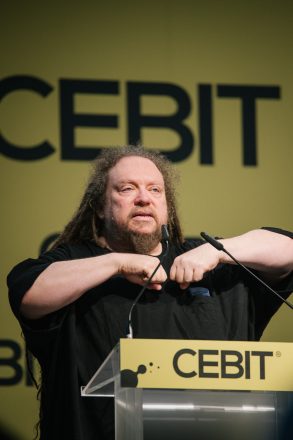What might we expect from the “new” Cebit? A bit of color, lots of English buzzwords from the startup industry and some music to top it off – is the IT trade fair turning into a festival? Will the fair manage to attract more attendees and keep its exhibitors? Munich Startup had a look around before the trade fair officially began.
Cebit, originally from the German “Centrum der Büro- und Informationstechnik” (Center for Office and Information Technology) is effectively a spin-off from the industrial Hannover Messe (HMI) that continuously attracted increasing numbers of visitors starting in 1986. And still – somehow, at some point in time – the fair lost touch. Groundbreaking innovations were introduced at other conferences. And that is why this year is supposed to be different.

The trade fair wants to appeal to young companies, retain technology leaders and attract new visitors. 2018 offers a Drone Battle, more startup pitches than previously, a Fuckup Night, Business Speed Dating and much more. Formats that might be new to veteran visitors have long since been the norm in the startup scene. Other possible brave moves: to have the ‘Smart Mobility’ solutions available as a real testing area outdoors. To have service robots as additional information points. To actually do what is discussed in the conference area for “Take off Monday.”
And if you think that’s quite a lot of criticism:
“The criticist is the true optimist,”
said Jaron Lanier, keynote speaker and VR icon, who has been a Cebit visitor since the 80s. According to his theory, pessimists and those who point out what could be done better can ultimately make the world a better place.
“AI-driven mind control machine”

Lanier’s speech is surprising for a tech trade fair. He spoke about the dark side of technology and particularly about “behavior manipulation and mass mind control” practiced by individual companies such as Google or Facebook. When asked how much worse it could get, he answer was to compare the situation with fascists gaining power during the Second World War and extortion by the mafia.
“I find it terrifying and humiliating […] that our very best intentions turned into the worst version,”
said Lanier. As unexpected as the subject of his keynote might be, his speech can inspire those developing innovative technologies to take a closer look. Which business model should I choose? How can society change positively by using innovations and reap lasting benefits from new technologies? How can we find collaborative approaches instead of stand-alone solutions and silo mentalities?
Cebit: Collaborative solutions instead of silo mentalities?
Just one look in the exhibition halls confirms that Cebit is a conference where exceptional innovations are presented (see our next article for more). Yet regardless of whether the focus is on autonomous driving, humanoid robots, IT security or AI solutions — the fact is that countless companies from around the world are working on the same subjects at the same time. While that can lead to better products due to competitive pressure, a different aspect to consider would be to collaborate and work on revolutionary discoveries together.
That might be something Cebit can contribute to with its new, more open-minded festival character. But will it work? That remains to be seen, since tomorrow is the first official day of the trade fair (read more about Cebit in our article about opening day).



